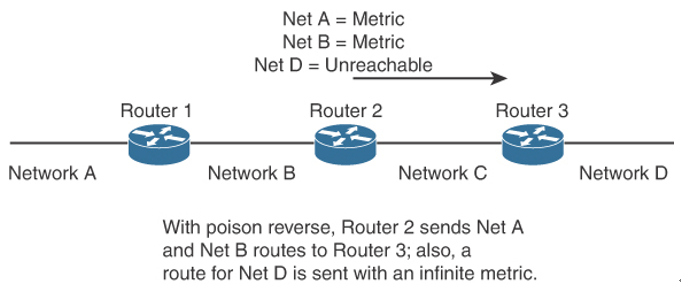Poison reverse is a route update sent out an interface with an infinite metric for routes learned (received) from the same interface. Poison reverse simply indicates that the learned route is unreachable. It is more reliable than split horizon alone. Examine Figure 3-7. Instead of suppressing the route for Network D, Router 2 sends that route in the routing table marked as unreachable. In RIP, the poison-reverse route is marked with a metric of 16 (infinite) to prevent that path from being used.

Figure 3-7 Poison Reverse
Counting to Infinity
Some routing protocols keep track of router hops as a packet travels through the network. In large networks where a routing loop might be present because of a network outage, routers might forward a packet without it reaching its destination.
Counting to infinity is a loop-prevention technique in which the router discards a packet when it reaches a maximum limit. It assumes that the network diameter is smaller than the maximum allowed hops. RIP has a maximum of 16 hops, and EIGRP has a maximum of 100 hops by default. Maximum values are considered infinity.
Triggered Updates
Another loop-prevention and fast-convergence technique used by routing protocols is triggered updates. When a router interface changes state (up or down), the router is required to send an update message, even if it is not time for the periodic update message. Immediate notification about a network outage is key to maintaining valid routing entries in all routers in the network by allowing faster convergence. Some distance-vector protocols, including RIP, specify a small delay to avoid having triggered updates generate excessive network traffic. The time delay is variable for each router.
Summarization
Another characteristic of routing protocols is the ability to summarize routes. Protocols that support VLSM can perform summarization outside IP class boundaries. By summarizing, a routing protocol can reduce the size of the routing table, and fewer routing updates occur on the network.
EIGRP
Cisco Systems released Enhanced Interior Gateway Routing Protocol (EIGRP) in the early 1990s as an evolution of IGRP toward a more scalable routing protocol for large internetworks. EIGRP is a classless protocol that permits the use of VLSM and that supports CIDR for the scalable allocation of IP addresses. EIGRP does not send routing updates periodically, as does IGRP. EIGRP allows for authentication with MD5. EIGRP autosummarizes networks at network borders and can load share over unequal-cost paths. Packets using EIGRP use IP number 88. Only Cisco routers use EIGRP. However, Cisco has released EIGRP as an IETF draft, so it might be possible that other vendors will implement EIGRP in their network devices.
EIGRP is an advanced distance-vector protocol that implements some characteristics similar to those of link-state protocols. Some Cisco documentation refers to EIGRP as a hybrid protocol. EIGRP advertises its routing table to its neighbors as distance-vector protocols do, but it uses hellos and forms neighbor relationships as link-state protocols do. EIGRP sends partial updates when a metric or the topology changes on the network. It does not send full routing table updates in periodic fashion as do distance-vector protocols. EIGRP uses Diffusing Update Algorithm (DUAL) to determine loop-free paths to destinations. This section discusses DUAL.
By default, EIGRP load balances traffic if several paths have an equal cost to the destination. EIGRP performs unequal-cost load sharing if you configure it with the variance n command. EIGRP includes routes that are equal to or less than n times the minimum metric route to a destination. Like RIP and IGRP, EIGRP also summarizes IP networks at network boundaries.
EIGRP internal routes have an administrative distance of 90. EIGRP summary routes have an administrative distance of 5, and EIGRP external routes (from redistribution) have an administrative distance of 170.